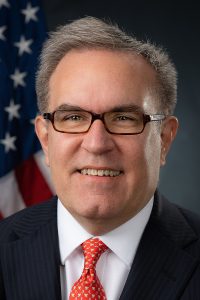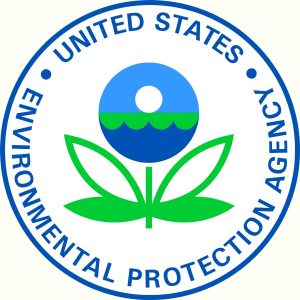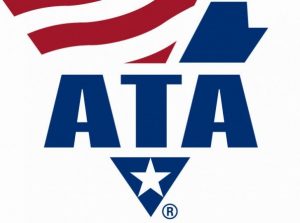The U.S. Environmental Protection Agency (EPA) will launch a new rule to further cut emissions of nitrogen oxide (NOx) from diesel-powered, heavy duty trucks, agency officials said recently. EPA said it intends to publish a proposed NOx rule in early 2020.
While the EPA has been rolling back dozens of environmental rules, it is now attempting to forestall a patchwork of federal and state rules on NOx emissions from commercial vehicles.
California to prefer national rule
Indeed, even as California moves toward writing new state emissions rules, trucking and truck manufacturing lobbying groups – along with state environmental officials – have been pushing EPA to set a new nationwide rule on allowable NOx emissions for diesel trucks.
California officials said they would actually prefer a national rule, if it is tight enough, because more than half the trucks delivering goods there are registered in other states.
Cleaner Trucks Initiative

Andrew Wheeler, EPA Acting Administrator
Enjoying our insights?
Subscribe to our newsletter to keep up with the latest industry trends and developments.
Stay InformedEPA has tagged its new effort as the “Cleaner Trucks Initiative,” which Acting Administrator Andrew Wheeler said will include a “future” rule-making that will update the existing (federal) NOx standard. It was last set in 2001. In addition, he said the new rule would “streamline” compliance and certification requirements. (more on Cleaner Trucks Initiative)
“The Cleaner Trucks Initiative will help modernize heavy duty truck engines, improving their efficiency, and providing cleaner air for all Americans,” Wheeler said. “The U.S. has made major reductions in NOx emissions, but it’s been nearly 20 years since EPA updated these standards. Through rule-making and a comprehensive review of existing requirements, we will capitalize on these gains and incentivize new technologies to ensure our heavy duty trucks are clean and remain a competitive method of transportation.’’
Bill Wehrum, assistant administrator of EPA’s office of air and radiation, said:
“Today’s announcement makes clear that reducing NOx emissions from heavy-duty vehicles is a clean air priority for this administration. EPA’s Cleaner Trucks Initiative is an important signal to all interested stakeholders that we will work hard on reducing emissions while producing a more effective and efficient program.”
More work to be done
EPA is not required by statue to update the NOx standard. However, in a news release, the agency asserted that although U.S. NOx emissions fell by more than 40 percent from 2007 to 2017, “there is more work to be done.”
EPA estimates that heavy duty trucks will be responsible for one-third of NOx emissions from the transportation sector in 2025. The agency said “any update to the standards will result in significant mobile source NOx reductions, which will aid communities across the country in the attainment of ozone and particulate matter standards.”
Referencing the agency’s recent rollback of more than two dozen regulations, EPA said that in addition to NOx emissions standards, the “CTI will cut unnecessary red tape while simplifying certification of compliance requirements for heavy-duty trucks and engines.”
The agency said that “areas of deregulatory focus will include on-board diagnostic requirements, cost-effective means of reassuring real world compliance by using modern and advanced technologies, the deterioration factor testing process, and concerns regarding annual recertification of engine families.”
Volvo Trucks comments
Commenting on the EPA initiative, John Mies, manager of corporate communications for Volvo Group North America (parent of Volvo Trucks North America and Mack Trucks) said his company supports the agency’s decision to investigate whether additional NOx reductions are needed to address any of the nation’s last remaining air quality challenges.
“This is a great opportunity to update and streamline the certification and compliance processes, ensuring a focus on real-world emissions control with minimal impediment to market vitality,” he said.
Mies added that, historically speaking, trucking has “delivered dramatic emissions reductions in response to EPA’s leadership in developing challenging but practical national emissions regulations.”
ATA applauds EPA
American Trucking Associations (ATA) also applauded EPA for “taking the first step” toward issuing new NOx standards.
“As an industry engaged in interstate commerce, ATA strongly favors a single national emission pathway as opposed to a patchwork of state standards,” said Bill Sullivan, ATA’s executive vice president of advocacy.
He pointed out that trucking has “repeatedly demonstrated that it can work proactively and in partnership with the federal government in achieving these aims. We look forward to working with the EPA in developing a standard that achieves nationwide air quality improvements across the country while maintaining a strong and robust economy.”
Cummins supports EPA
Global diesel engine maker Cummins Inc. also announced support for the EPA effort.
“Cummins has a long history of working with regulators to help develop tough, clear and enforceable standards that lead to a cleaner, healthier and safer environment,” said Jennifer Rumsey, vice president. “We can and should do more to reduce NOx. This is an important step forward because a streamlined, national regulatory program brings consistency across the country allowing manufacturers to develop cleaner, more cost-effective solutions for our customers.”
Diesel Technology Forum chimes in
The Diesel Technology Forum (DTF) advocacy group said that EPA’s action “follows petitions for rule making from a number of state and local air agencies, as well as support for a new low NOx standard from truck and engine makers. The EPA last revised these standards in January 2001. The CTI proposal [rulemaking] is slated to be released in 2020.”
DTF added that it expects the planned low-NOX rule making for trucks will “help bring today’s generation of diesel even nearer to zero emissions than ever before.”
Truck and Engine Manufacturers Association ready for change
Jed Mandel, president of the Truck and Engine Manufacturers Association, said the Cleaner Trucks Initiative is “a tremendous opportunity. We – EPA and the manufacturers – have done this before, and we’re ready to step forward to do it again. We ask the agency to follow that same successful roadmap by leading a collaborative, open regulatory process involving all stakeholders.”
Mandel also stated that adopting a national low-NOX truck program with sufficient regulatory lead time, stability and certainty will be essential to provide a clear path for truck and engine manufacturers to succeed.
Officials at Daimler Trucks North America said it “strongly supports the EPA’s initiative to streamline regulatory requirements and improve air quality, while maintaining a regulatory framework that encourages reliable, durable products with low total cost of ownership.”
(from HDT Truckinginfo)
























